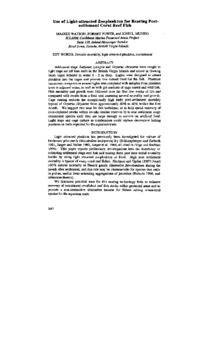Use of light-attracted zooplankton for rearing post-settlement coral reef fish

Citation
Watson, M.; Power, R.; Munro, J.L. (1999). Use of light-attracted zooplankton for rearing post-settlement coral reef fish. p. 340-351. In: Proceedings of the 51st Annual Gulf and Carribbean Fisheries Institute, Key West, Florida USA
Settlement stage Lutjanus synagris and Ocyurus were caught in light traps set off fore reefs in the British Virgin Islands and raised in floating mesh cages tethered in water 1-2 m deep. Lights were designed to attract plankton into the cages and provide live natural food for the fish. Plankton taxonomic composition around lights was compared with samples from plankton tows in adjacent water, as well as with gut contents of cage reared and wild fish. Fish mortality and growth were followed over the first few weeks of life and compared with results from a field trial assessing natural mortality and growth. Cage rearing reduces the exceptionally high early post settlement mortality typical of Ocyurus chrysurus from approximately 80% to 40% within the first month. We suggest two uses for this technique, a) to help speed recovery of over-exploited stocks with no-take marine reserves b) to rear settlement stage ornamental species until they are large enough to survive on artificial food. Light traps and cage culture in combination could replace destructive fishing practices on reefs exploited for the aquarium trade.
Permalink
Date Available
Type
Publisher
Research Themes
Topics
Language